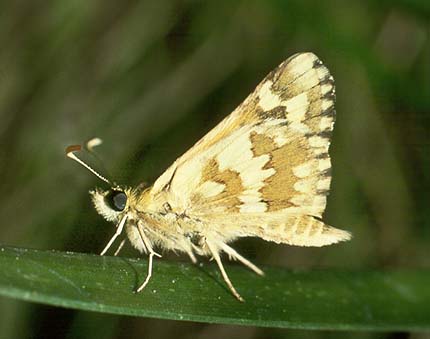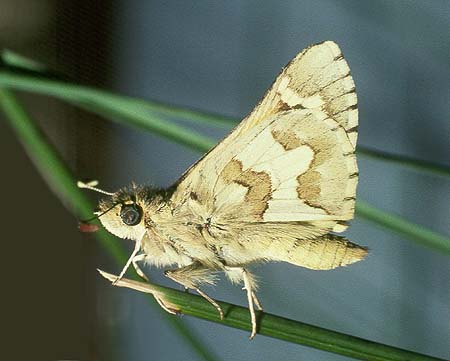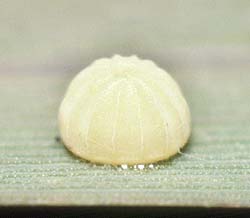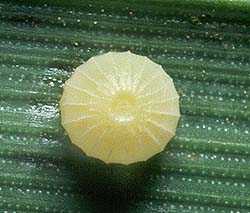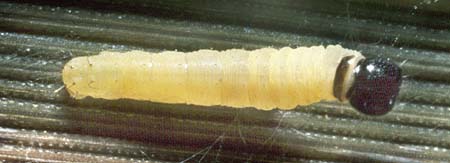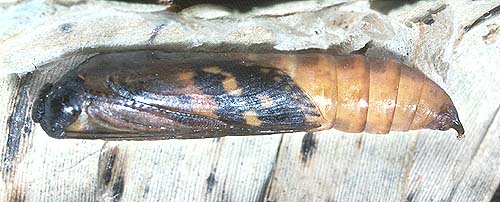-
Larval Food Host
-
Austrostipa acrociliata (graceful spear-grass),
A. elegantissima (elegant spear-grass),
A. platychaeta (flat-awned spear-grass),
Enteropogon acicularis (branching umbrella or curly windmill grass),
E. ramosus (tussock umbrella grass or windmill grass) (Poaceae).
The Austrostipa host occurs mostly in the southern half of the state,
particularly in mallee woodland, while the Enteropogon occurs mostly
in the Far North pastoral areas. Larvae of the northern race normally feed on
Enteropogon acicularis but will also utilise E. ramosus if it is present.
Larvae of the southern race occurring on northern Eyre Peninsula normally feed on
Austrostipa platychaeta. On the Far West Coast the hostplant is normally
A. acrociliata, yet interestingly the skipper has not been seen to use this grass
in northern Eyre Peninsula. Females of the southern race will sometimes also lay on
A. elegantissima if it is growing nearby to the former preferred plants.
The larvae eat the leaves of the hostplant. Larvae of the southern race readily switch to
Enteropogon in a captivity situation.
A. platychaeta is a tall, multi-branched grass (~ 1 m), usually very open in
growth with a purple flower head, and is heavily grazed by both stock and kangaroos,
and where not protected only survives by growing within low shrubs with the tops of
the grass protruding above the protective shrubs. As its common name indicates, the
awn or long hair-like tail to the seed is flattened in cross section and cannot be
rolled between thumb and forefinger. The very similar A. acrociliata is more
often multi-stemmed and has a seed awn that is rounded in cross section and can be
rolled between thumb and forefinger.
-
Eggs
-
Small, nearly hemispherical (domal) shaped, base flat circular, with strong,
faintly beaded vertical ribs, and indistinct horizontal inter-ridges. Pale
yellow when newly laid, and they do not later acquire red markings if fertile.
The small micropylar area on top of the egg is depressed. Laid singly on the
leaves of the hostplant, although with successive layings (by the same or
different females) two or three eggs may occur on a single blade of grass.
The egg shell is eaten by the larva after its emergence. Eggs of the northern
race have 13-16 vertical ridges, while the southern race has 16-24 vertical
ridges, although the ridge numbers are likely affected by the size of the
individual female. Larvae of the northern race start to hatch (eclose) after
12 days, while those of the southern race start eclosing in early-mid spring
after 16-18 days on Eyre Peninsula, decreasing to 11-16 days in the Far West Coast.
Females of the northern race seem to have an egg laying preference for hostplants
in the shade of large red gums and other trees. This shady situation may help to
delay the drying out of the hostplants during periods of no rain. Selected
hostplants are usually small and in lush growth. Eggs are laid singly on the upper
sides of the leaves, along the inner half. The female of the southern race lays
eggs on the upper surface of the hostplant leaves that occur about halfway up the
plant, and usually near the leaf axil.
-
Larvae
-
The first instar is long cylindrical, initially entirely pale yellow except on the
Far West Coast where the larvae sometimes have the posterior portion orange coloured.
In all cases they gradually turn green after eating the hostplant, with a large shining
black head having a few long hairs, the neck (prothoracic plate) is dark brownish black,
and long recurved hairs occur posteriorly. After eating the empty eggshell the larva
will move to near the tips of the leaves to form a small tubular shelter, which it does
by either folding lengthways or by rolling over a portion of the leaf and continuously
joining the edges together with silk so that no gap is left between the leaf edges.
The young larva rests in the shelter during the day with its head pointing downwards
towards the leaf axil. Initially the shelter is open ended but eventually the distal end
is sealed with silk. The larva eats at dusk by feeding on the edges of the leaf.
Subsequent instars gradually acquire pale and dark longitudinal lines and lose the long
posterior hairs, the head gradually becomes paler and gets a brown frontal marking and
eventually by about the fourth instar acquires the head pattern described for the final
(fifth) instar larva. New shelters are periodically constructed to fit the growing larvae.
In the case of the northern race, the larvae use the leaves of the hostplant, and the
internal diameter of the shelters is almost an exact fit to the diameter of the larvae.
The shelters are usually open at the bottom (towards the leaf axils) and sealed at the
top, which typifies this tribe of skippers. Initially they may continue to roll single
leaves to make their shelters, but as the larvae grow increasingly larger they will use
two or more leaves to construct more elaborate shelters. The shelters are very strongly
lined with silk. The early instars of the northern race tend to make shelters in the
outer parts of the hostplant using young green leaves, while mature larvae tend to make
the shelters within the old congested and curly leaves in the lower parts of the hostplant.
A mature larva can silk together a shelter within two hours. With the southern race,
the leaves of the A. platychaeta hostplant are usually too small and sparse to
support shelter construction for late instar larvae, and so the these larvae have to
construct shelters from leaf debris either caught within the hostplant, or around the
base of the hostplant, or from leaves on the protective shrubs within which the hostplant
is growing. Larvae continue to rest and hide from predators within the shelters during
the day with their heads directed downwards. They emerge to eat very briefly at dusk
(usually) or dawn (rarely). When the larvae are larger they will eat leaves anywhere
on the plant, leaving characteristic jagged sawtooth-like edges to the leaves.
This skipper has developed survival means to overcome the periodic extended dry periods,
and which is another feature common to the tribe of skippers in which this skipper is
a member. Its larvae can enter into a dormant diapause condition when the hostplant
grass becomes too dry or rank to eat. Larvae of the southern race normally reach a late
instar stage by mid summer then undergo diapause until the autumn rains begin. They then
break diapause to feed slowly on the rejuvenated green growth of their hostplants through
winter until their pupation in late winter and early spring. During the diapause stage
the larvae turn brown or orange brown, and slowly shrink in size. In captivity they can
survive in this diapause stage for about 9 months, but after that time the diapause seems
to be terminally fatal to the larvae.
In captivity, a similar diapause period is witnessed for the northern race. This would be
of immense benefit for this race under the hot, arid conditions of central Australia.
In this situation it is surmised the larvae would enter diapause when the hostplant grass
became too dry or rank to eat in periods of no rain. The larvae would remain in this
condition until rains again fell in the region to promote new growth of the grass. Under
the latter conditions, the larvae would rapidly finish off late stage larval development
and pupate so that the emergent adults could take advantage of any rejuvenated green growth
of their hostplant and a blossoming of nectar plants.
The final instar is long cylindrical shaped, about 23-28 mm long (the southern race are
longer), slightly thickened in the middle, with the last posterior segment flattened into
the anal plate, smooth, but with the posterior end having some hairs. The head is large,
finely rugose, elongate and slightly flattened, there is a slight central longitudinal
furrow, the top is squared, noticeably hairy with pale coloured hairs that are simple and
pointed, with longer hairs laterally, but those hairs on the front being bent and directed
forward. The body colour is variable, being pale yellowish brown or greenish brown to pale
brownish green, paler posteriorly and often orange tinted, pinkish anteriorly (more noticeable
in green coloured larvae) and the anal plate is also sometimes pinkish, with a dark green or
dark greenish brown longitudinal dorsal line, a pale yellow longitudinal subdorsal line
edged ventrally dark brown or dark green, and the anal plate and neck are speckled black.
The head is mostly yellowish brown, sometimes darker on the side of the head, with a central
pair of pale brown longitudinal lines on the front converging dorsally to an inverted V shape,
and the mouth parts are either black, dark brown or pale brown coloured. The body, and
particularly the anal plate on the last segment, have some tiny secondary setae that are
elongate vase shaped, and which are set on simple smooth raised black coloured bases.
Larvae of the southern race are usually green forms, while the northern race larvae are
more often pale yellowish brown coloured. Green coloured forms seem to be more prevalent
when growth development occurs in the shade.
The presence of larvae on the hostplant is discernible by the characteristic large jagged
eat marks at the edges of the leaves.
-
Pupae
-
Short cylindrical, nearly smooth without abdominal bristles, about 12-15 mm long in the
Far North and 16-20 mm long for the southern race. The former is sub-translucent yellowish
brown, darker brown anteriorly and posteriorly, while the latter can be sub-translucent
yellow, yellowish brown or orange coloured. The anterior thoracic part can sometimes be
brownish, particularly when it is old. Sometimes there are narrow black intersegmental
abdominal rings. The posterior end tapers to a short, relatively broad, rounded, dark brown
cremaster. The head is rounded, with the head cap (operculum) being black coloured, and having
a characteristic shape. The central part of the operculum is heavily sclerotised (very rugose)
and is divided into a larger ventral part, and two smaller equal-sized dorsal parts. There are
further, smaller less sclerotised areas lateral to the central part.
Pupation occurs in the final larval shelter on the hostplant, and the larva pupates head
downwards, directed towards the leaf axils. The pupa is secured within the silk lined
shelter by very strong hooked bristles emanating from the end of the cremaster. The pupal
duration is about 12-16 days for the northern race in captivity, and 11-18 days for the
southern race in summer captivity. The empty pupal case remains inside the shelter after
the adult skipper emerges, and is brown coloured.
The shape of the operculum and cremaster, the colour of the pupa (alive or as an empty case),
and the morphological properties of the larva or discarded larval skin are diagnostic for the
species and can be used during field surveys to differentiate C. arenaria from other
skipper species in South Australia outside of the flight times for the adult skippers.
-
Flight Period in South Australia
-
The incomplete observation records for the northern race in South Australia are for mid
September-early October and late April-early May. In the nearby Northern Territory the
skipper has been seen flying in late September-mid October and there are also records
for late January and late May. However, the skipper probably has an opportunistic flight
pattern in central Australia dependant on the infrequent rains that promote rejuvenated
growth of the perennial hostplant grasses. These rains can occur as semi-reliable light
winter rains which would likely promote a regular flight in spring, and infrequent heavy
monsoon thunderstorms during late spring to autumn. During times of good rains the skipper
can complete a brood in 12 weeks in late spring to early summer. Observations during the
hot months show that the early stages of the skipper are present on the hostplants in all
stages of development. The skipper normally overwinters as larvae.
The southern race is presently known to fly in the wild from early September to mid October,
with most of the males emerging earlier in the season than the females. Some specimens reared
over winter in Adelaide have emerged in mid-November. Eggs obtained during the spring flight
have also produced adults in captivity during the following late December to late January,
which suggests that during seasons of good summer rainfall the skipper may be capable of
producing further secondary summer flights in the wild. During early 2011, good summer rains
on the Far West Coast and northern Eyre Peninsula produced a flight from mid-March to mid-April.

-
Distribution
-
The northern race has only recently been found to occur in South Australia (2000),
where it is present along several ephemeral creeks and rivers in the Northwest Region
that feed into the west side of Lake Eyre. Its larval hostplant (curly windmill grass)
is widely distributed in the northern areas of the state and so the skipper may have a
wider distribution than presently known as the skipper is small (bee-size) and is easily
overlooked, and occurs in an area that has been poorly surveyed for butterflies. This
race of the skipper is also known to occur sporadically in similar habitat in adjacent
areas of the Northern Territory. There has also been a possible sighting in southwest
inland Qld. The southern race is known to occur in northern Eyre Peninsula, the Far West
Coast and inland in the Immarna area. It has yet to be found east of Spencer Gulf, even
though its hostplants are present, and it is suspected the historical use of toxic sprays
for locusts in grasslands and overgrazing practices may have exterminated them from this
region. The hostplants also occur in cool southern temperate areas, but the skipper must
have certain biological requirements as it has yet to be recorded in these areas.
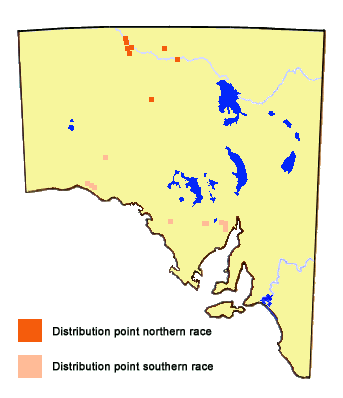
-
Habitat
-
The northern race favours open woodland habitat on the dry side. In South Australia it
is presently only known to occur along the ephemeral creek and river systems in the
arid northwest of the state, where its perennial grass hostplants (Enteropogon species)
commonly occur, and remain in a living condition throughout the year. During good seasons,
the adults probably either migrate out of the creek lines (and eventually get lost), or move
up and down the creek lines following the occurrence of the hostplants. The southern race in
its eastern occurrence favours open mallee habitat growing in rocky hill areas, but recently
has also been seen in mallee and southern pastoral habitat occurring in a flat plain situation.
In its western occurrence it occurs in the swale areas of open mallee growing in dune systems,
but particularly in a roadside situation where water runoff collects.
-
Conservation Status in South Australia
-
The northern race is only seen sporadically and adults usually occur in low numbers
at any one location, and on that basis is considered to be rare. However, its early
stages are more frequently seen. The annual rainfall in the Far Northwest Region of
SA decreases in an easterly direction towards Lake Eyre where the hostplant remains
in a green condition for a much shorter period during the year and consequently the
skipper becomes very rare in the eastern limits of its range. The southern race on
Eyre Peninsula is exceedingly rare in flight, and was only discovered in 1987. It is
more often noticed from the presence of its early stages. On the Far West Coast and
Immarna the skipper tends to be very local.
-
Threats
-
The main threats for the northern race would be drought, periodic floods, and the effects
of pastoral disturbances through over-grazing and trampling by cattle. The southern race
on Eyre Peninsula occurs in remnant native vegetation at the fringes of the agricultural
belt and is susceptible to toxic spray drift from adjoining farm lands, especially when
it is applied by aerial means. In Far West areas the main threats are again drought,
euphemeral floods, and also possible effects of the mining industry particularly when
accessing subsurface water that may impact on the vegetation. The hostplants are very
susceptible to grazing animals, particularly stock, feral goats and rabbits, but also
to kangaroos.
-
Conservation Strategy
-
Remaining remnant areas of pristine native vegetation containing the hostplants of
the southern race should not be unecessarily cleared or severely degraded within
the skipper's distributional range. Feral goats (particularly) and rabbits need to
be kept under control in rocky habitat. Kangaroos should not be allowed to build up
to plague numbers within the range of the southern race. The northern race and the
southern race in its western occurrences mostly occur on aboriginal lands where cattle
grazing no longer occurs, and so should be reasonably protected.
